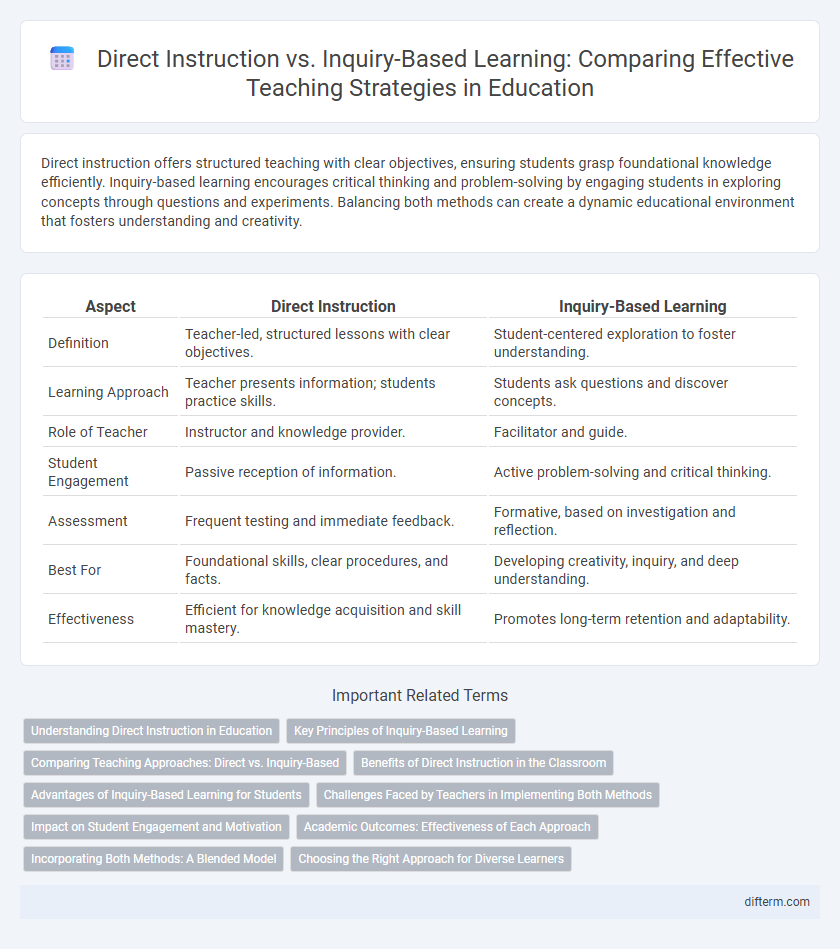Direct instruction offers structured teaching with clear objectives, ensuring students grasp foundational knowledge efficiently. Inquiry-based learning encourages critical thinking and problem-solving by engaging students in exploring concepts through questions and experiments. Balancing both methods can create a dynamic educational environment that fosters understanding and creativity.
Table of Comparison
| Aspect | Direct Instruction | Inquiry-Based Learning |
|---|---|---|
| Definition | Teacher-led, structured lessons with clear objectives. | Student-centered exploration to foster understanding. |
| Learning Approach | Teacher presents information; students practice skills. | Students ask questions and discover concepts. |
| Role of Teacher | Instructor and knowledge provider. | Facilitator and guide. |
| Student Engagement | Passive reception of information. | Active problem-solving and critical thinking. |
| Assessment | Frequent testing and immediate feedback. | Formative, based on investigation and reflection. |
| Best For | Foundational skills, clear procedures, and facts. | Developing creativity, inquiry, and deep understanding. |
| Effectiveness | Efficient for knowledge acquisition and skill mastery. | Promotes long-term retention and adaptability. |
Understanding Direct Instruction in Education
Direct instruction in education emphasizes structured, teacher-led lessons with clear objectives, explicit teaching, and systematic assessment. This method enhances student comprehension by breaking complex concepts into manageable steps, promoting mastery through repetition and immediate feedback. Research shows that direct instruction effectively supports early literacy, math skills, and special education, offering measurable outcomes and efficient knowledge acquisition.
Key Principles of Inquiry-Based Learning
Inquiry-based learning emphasizes student curiosity, active exploration, and critical thinking as core principles, encouraging learners to formulate questions, investigate solutions, and reflect on their findings. This approach contrasts with direct instruction by fostering deeper understanding through hands-on experiences and promoting learner autonomy. Key elements include encouraging problem-solving skills, collaboration, and integrating real-world contexts to enhance engagement and retention.
Comparing Teaching Approaches: Direct vs. Inquiry-Based
Direct instruction emphasizes structured, teacher-led lessons with clear objectives and step-by-step guidance, promoting efficient knowledge acquisition and skill mastery. Inquiry-based learning encourages student exploration, critical thinking, and problem-solving by allowing learners to investigate questions and construct understanding independently. Comparing these approaches reveals direct instruction excels in delivering foundational knowledge quickly, while inquiry-based learning fosters deeper conceptual understanding and long-term retention through active engagement.
Benefits of Direct Instruction in the Classroom
Direct instruction enhances student learning outcomes through structured, teacher-led lessons that clearly define objectives and expectations, ensuring efficient knowledge transmission. This method supports diverse learners by providing consistent practice and immediate feedback, which reinforces skill mastery and retention. Research indicates that direct instruction improves foundational skills in reading and math, leading to higher standardized test scores and academic achievement.
Advantages of Inquiry-Based Learning for Students
Inquiry-based learning promotes deeper understanding and critical thinking by encouraging students to explore concepts through questioning and investigation. This approach enhances problem-solving skills and fosters creativity by allowing learners to construct knowledge actively rather than passively receiving information. Research shows that students engaged in inquiry-based learning demonstrate higher retention rates and greater motivation compared to traditional direct instruction methods.
Challenges Faced by Teachers in Implementing Both Methods
Teachers encounter significant challenges when implementing direct instruction, such as maintaining student engagement and addressing diverse learning paces within a structured framework. Inquiry-based learning presents difficulties including time constraints, insufficient training, and managing varying levels of student autonomy, which can hinder effective classroom management. Balancing these methodologies requires educators to adapt continually while ensuring curriculum standards are met and learning outcomes achieved.
Impact on Student Engagement and Motivation
Direct instruction enhances student engagement by providing clear, structured guidance and immediate feedback, which helps maintain focus and confidence in mastering content. Inquiry-based learning fosters intrinsic motivation by encouraging curiosity, critical thinking, and active exploration, leading to deeper understanding and sustained interest in the subject matter. Studies show that combining both methods can optimize student engagement and motivation by balancing clarity with creativity in the learning process.
Academic Outcomes: Effectiveness of Each Approach
Direct instruction consistently leads to higher immediate academic achievement by providing clear, structured lessons that target specific learning objectives. Inquiry-based learning fosters deeper critical thinking and problem-solving skills, resulting in improved long-term understanding and retention. Studies show a blend of both methods optimizes academic outcomes by balancing foundational knowledge acquisition with exploratory learning experiences.
Incorporating Both Methods: A Blended Model
A blended model that combines direct instruction and inquiry-based learning enhances student engagement and understanding by balancing structured guidance with exploratory discovery. Direct instruction provides clear, systematic teaching of foundational concepts, while inquiry-based learning fosters critical thinking and problem-solving skills through hands-on investigation. Integrating both methods creates a dynamic classroom environment tailored to diverse learning styles and promotes deeper mastery of educational content.
Choosing the Right Approach for Diverse Learners
Direct instruction provides structured, explicit teaching methods ideal for learners who benefit from clear guidance and step-by-step processes, enhancing skill acquisition efficiently. Inquiry-based learning fosters critical thinking and problem-solving by encouraging students to explore concepts independently, suited for learners who thrive in self-directed environments. Selecting the appropriate approach depends on individual learner needs, cognitive styles, and subject complexity to optimize educational outcomes.
direct instruction vs inquiry-based learning Infographic

 difterm.com
difterm.com